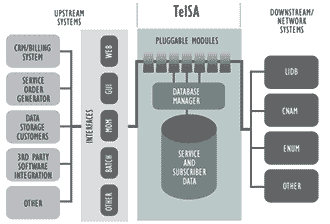 |
Single Point-of-Administration for PSTN, VoIP, and Next-Generation Services and Subscribers |
 |
| About EGH | Technologies & Solutions |
TelSA Product Suite |
Support Services |
Partnering with EGH |
Dissolution Notice |
|
|
|
TelSA Architecture, and Why
TelSA Core’s architecture combines the flexibility of modern enterprise messaging technology with the power of a sophisticated data model and repository. It enables the flow of information from a wide array of sources, such as CRM and Service Ordering Systems, to a provider’s choice of downstream systems, bridging the gap between legacy or proprietary interfaces and today’s XML-based standards. At the same time, the architecture’s comprehensive data model and shared repository streamline administration of an ever-growing number of telecommunications services.TelSA’s design minimizes the cost of its required operating environment. It is compatible with a variety of operating systems. The largest configurations run comfortably on standard mid-range servers. Key components of TelSA Core include:
|
||||||||||||||||
EGH
